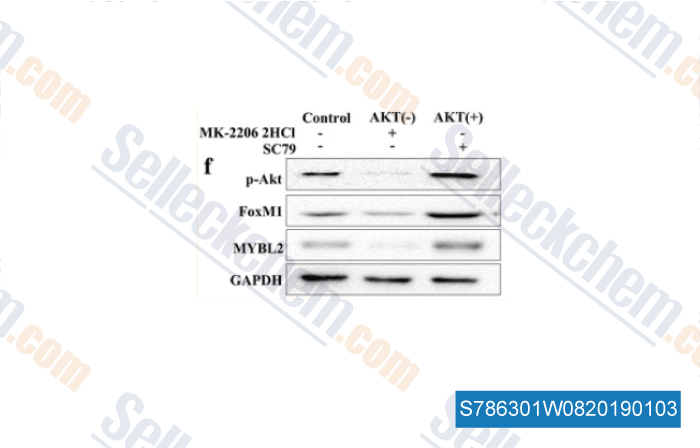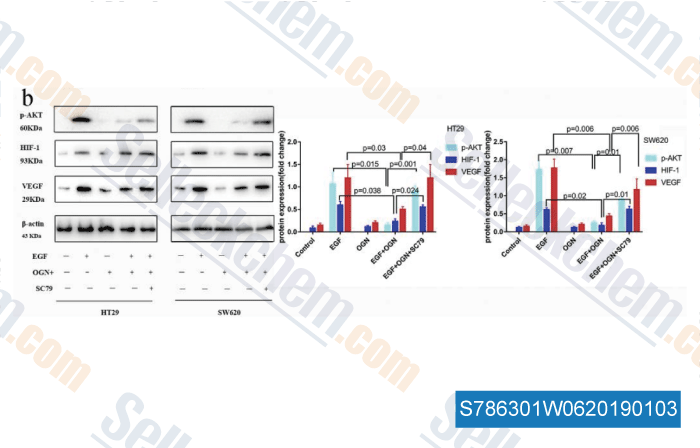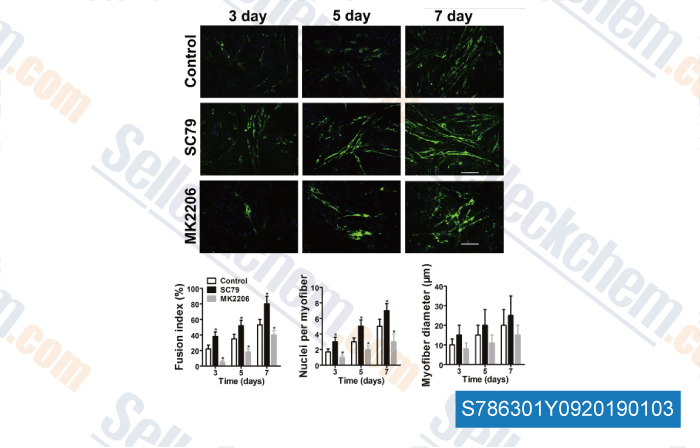|
Toll Free: (877) 796-6397 -- USA and Canada only -- |
Fax: +1-832-582-8590 Orders: +1-832-582-8158 |
Tech Support: +1-832-582-8158 Ext:3 Please provide your Order Number in the email. |
Technical Data
| Formula | C17H17ClN2O5 |
||||||
| Molecular Weight | 364.78 | CAS No. | 305834-79-1 | ||||
| Solubility (25°C)* | In vitro | DMSO | 73 mg/mL (200.12 mM) | ||||
| Ethanol | 36 mg/mL (98.68 mM) | ||||||
| Water | Insoluble | ||||||
| In vivo (Add solvents to the product individually and in order) |
|
||||||
|
* <1 mg/ml means slightly soluble or insoluble. * Please note that Selleck tests the solubility of all compounds in-house, and the actual solubility may differ slightly from published values. This is normal and is due to slight batch-to-batch variations. * Room temperature shipping (Stability testing shows this product can be shipped without any cooling measures.) |
|||||||
Preparing Stock Solutions
Biological Activity
| Description | SC79 is a brain-penetrable Akt phosphorylation activator and an inhibitor of Akt-PH domain translocation. | |
|---|---|---|
| Targets |
|
|
| In vitro | SC79 suppresses PHAKTM-GFP plasma membrane translocation, and enhances phosphorylation of all three Akt isoforms in HEK293, HeLa, HL60, NB4, and HsSulton (B cells) cells. This compound reduces neuronal excitotoxicity and prevents stroke-induced neuronal death. [1] It restores proliferation of BRAT1 knockdown cells, and reduces the production of superoxide in mitochondria of MitoSox positive cells. [2] |
|
| In vivo | In the permanent focal cerebral ischemia mouse model, SC79 (0.04 mg/g, i.p.) enables the cytosolic activation of Akt, and recapitulates the primary cellular function of Akt signaling, resulting in augmented neuronal survival. [1] |
Protocol (from reference)
| Kinase Assay: |
|
|---|---|
| Cell Assay: |
|
| Animal Study: |
|
References
|
Customer Product Validation

-
Data from [ , , J Exp Clin Cancer Res, 2018, 37(1):41 ]

-
Data from [ , , J Exp Clin Cancer Res, 2017, 36(1):105 ]

-
Data from [ , , EBioMedicine, 2018, 34:35-45 ]

-
Data from [ , , Biochim Biophys Acta Mol Basis Dis, 2017, 1863(11):2848-2861 ]
Selleck's SC79 Has Been Cited by 180 Publications
| PI3K-Akt signalling regulates Scx-lineage tenocytes and Tppp3-lineage paratenon sheath cells in neonatal tendon regeneration [ Nat Commun, 2025, 16(1):3734] | PubMed: 40254618 |
| Autophagy inhibition improves the efficacy of anlotinib and PD-1 inhibitors in the treatment of NSCLC [ J Immunother Cancer, 2025, 13(9)e010812] | PubMed: 40983344 |
| YBX1/CD36 positive feedback loop-mediated lipid accumulation drives metabolic dysfunction-associated steatotic liver disease [ Int J Biol Sci, 2025, 21(5):2118-2134] | PubMed: 40083711 |
| Artemisinin Suppressed Melanoma Recurrence and Metastasis after Radical Surgery through the KIT/PI3K/AKT Pathway [ Int J Biol Sci, 2025, 21(1):75-94] | PubMed: 39744440 |
| Macrophages downregulate NEDD9 to counteract S. Typhimurium- mediated FAK-AKT activation and lysosome inhibition [ Cell Death Dis, 2025, 16(1):445] | PubMed: 40506423 |
| Fangchinoline suppresses nasopharyngeal carcinoma progression by inhibiting SQLE to regulate the PI3K/AKT pathway dysregulation [ Phytomedicine, 2025, 140:156484] | PubMed: 40090046 |
| S1PR3 inhibition impairs cell cycle checkpoint via the AKT/WEE1 pathway in oral squamous cell carcinoma [ J Transl Med, 2025, 23(1):573] | PubMed: 40410851 |
| Xiaoai Jiedu recipe reduces cell survival and induces apoptosis in hepatocellular carcinoma by stimulating autophagy via the AKT/mTOR pathway [ J Ethnopharmacol, 2025, 339:119135] | PubMed: 39586558 |
| STOML2 inhibits sorafenib-induced ferroptosis in hepatocellular carcinoma via p-AKT signaling pathway [ Am J Cancer Res, 2025, 15(4):1614-1628] | PubMed: 40371153 |
| The AKT-USP15 axis modulates autophagy in MPP+-induced Parkinson's disease model of SN4741 cells [ Cell Signal, 2025, 134:111879] | PubMed: 40441471 |
RETURN POLICY
Selleck Chemical’s Unconditional Return Policy ensures a smooth online shopping experience for our customers. If you are in any way unsatisfied with your purchase, you may return any item(s) within 7 days of receiving it. In the event of product quality issues, either protocol related or product related problems, you may return any item(s) within 365 days from the original purchase date. Please follow the instructions below when returning products.
SHIPPING AND STORAGE
Selleck products are transported at room temperature. If you receive the product at room temperature, please rest assured, the Selleck Quality Inspection Department has conducted experiments to verify that the normal temperature placement of one month will not affect the biological activity of powder products. After collecting, please store the product according to the requirements described in the datasheet. Most Selleck products are stable under the recommended conditions.
NOT FOR HUMAN, VETERINARY DIAGNOSTIC OR THERAPEUTIC USE.
